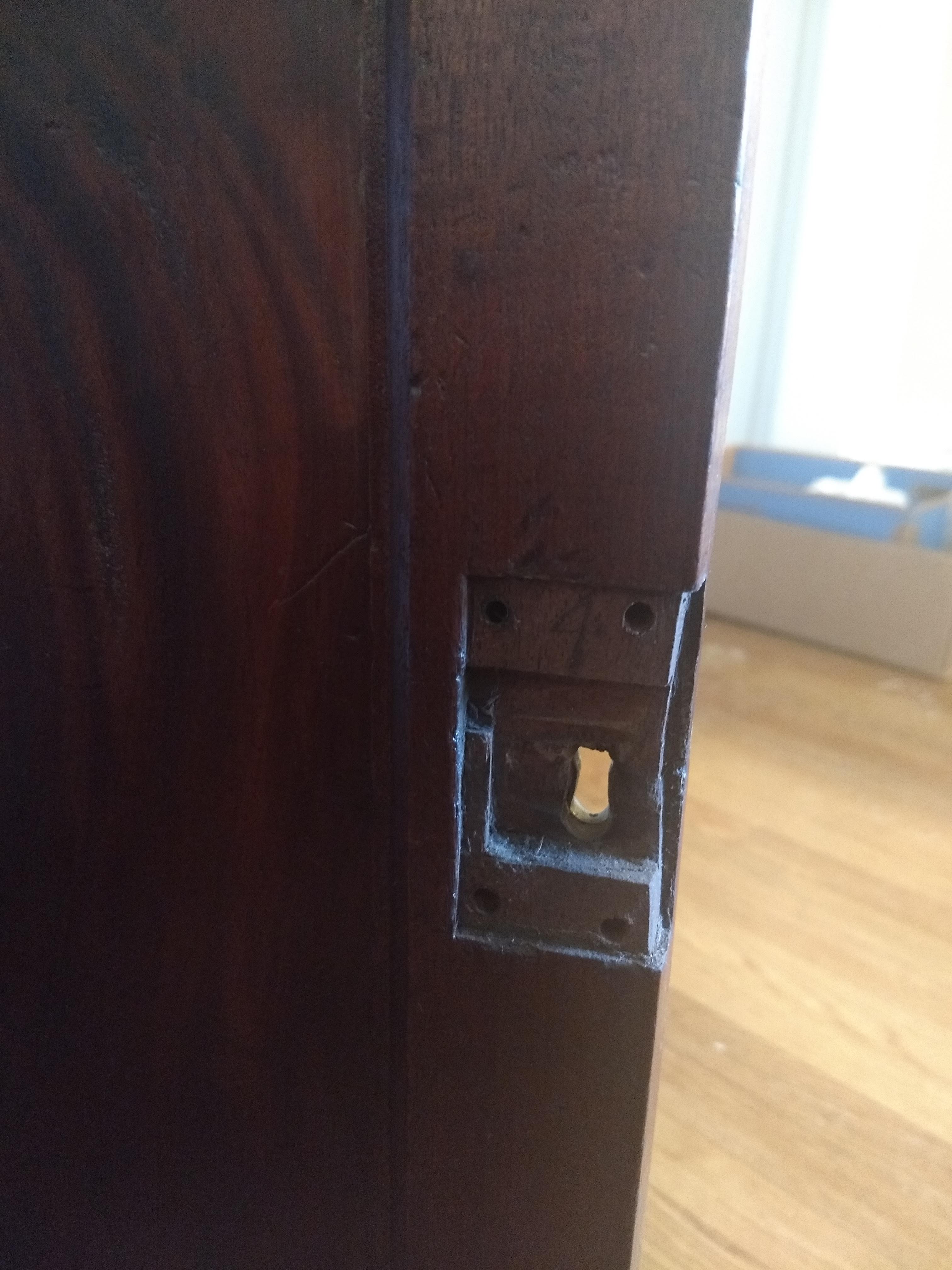I bought this bookcase on a whim at a local online estate auction. I paid $400 for it, because I was afraid to pay more without having the time to thoroughly inspect or research the piece. I just thought the design was beautiful. Later that day my husband and I picked up the piece, and it was already unscrewed so that the pieces were separated and easier to handle. Only then did I get a better look at the top and back side of the bookcase, and I realized the age. I had assumed it was just a 1930s-50s reproduction piece. But the top and back pieces were clearly made by hand out of pine. I did not note circular saw lines, but it appears to have the appearance of a hand saw on the back panels.
The front of the peice is also clearly made by hand, as little irregularities and knicks are visible. I can't quite figure it out. The piece does not look as flawless as an English made cabinet, but it is certainly quite a noble attempt at a complicated and statement piece for it's time. I wondered if it was a masterpiece by a young apprentice just settling in to his trade? I would love to know more about the age and origin of this bookcase, and perhaps who made it. But, I suppose that is completely unrealistic.
The glass is wavy and contains several visible "seed" bubbles. The interior of all cabinents are lined with notches that are hand carved/planed so as to allow for adjustable shelving. I attempted to move some of the shelves and found that the notches were imperfect enough that some of the shelves could not be moved into certain positions because of the irregularity of depth in the notches. The wood shelves have some staining in spots from what appears to be black ink spills.
The very top pediment is somewhat reminiscent of a pineapple, but I'm not sure. It is just a few inches shy of 8 feet in height at the tallest place. The dentil work on the molding is missing a few "teeth". The two scrolls have carvings of an ornate rose on each. This intricate design seems a bit more fussy than the bottom half of the piece, which made me think of a federal style cabinet. The banded inlay surrounding the flame mahogany doors seemed to indicate a post-1800 date to me. Also, there are no feet, just straight lines on the bottom half of the cabinet. The glass and pediment detailing reminded me a bit more of a Georgian style piece. This was confusing to me, trying to place the style. Would it be a transitional piece that combines two period styles?
In one picture you can see where my husband removed a lockset (it's a long story). I was fascinated to find a delicate "4" drawn in pencil lead on the wood beneath. The hidden underside of the brass lockset had a "4" also etched by hand. There are no brass hardware pieces with handles, but the locks are lined with brass, and the locksets are all brass. There appear to be small inclusions and irregularities on the backs of the locksets. They are all slightly different and some are filed in places so that each seems minutely unique. But relative uniformity was acheived. Most screws appear to be replacements and of motley sizes. I founds about 4 screws in the least handled/used places that appeared to be original. They were the oldest looking and smallest. I carefully removed one of these screws from the delicate brass stopper that held the main doors in place at the bottom. Upon close inspection I noticed the shaft of the screw appeared to have a hammered and uneven appearance. In one spot it even looked to have evidence of previously being somewhat flat prior to hammering. The threads were mostly even, but I felt I could see tiny marks between each thread that looked as if they could have been made by a file (handmade). The tip looked to have been broken off by the manufacturer. The heads of the oldest screws are all off set in regards to the divet on top. It looks consistent with what I have read about pre-1812 screws that were made by hand. The pictures I took were just with my phone, so the details are probably not very helpful. I also included a picture that shows a very old nail head I found, that also looks to be hand forged?
Anyway, I just really enjoy this piece of history, and imagining who made it and how he made his living. I want to take good care of it, as I can tell it has already undergone multiple moves and damages. It is hard for me to decipher the finish. Is it shellac or should I use danish oil to clean and care for it? I don't want to ruin it, and I'd love to give it a proper cleaning. Not sure if I should use a wax or oil. Any thoughts on style, age, location of building or any details welcomed. God bless,
R. Douglas













Re: Mahogany Breakfront Bookcase
Based on what I can see you are dealing with the "Real thing", something made no later than the early years of the 19th Century, the construction details you mention predate the 1850's, the screws are hand made. I'd suggest you have this piece physically examined by and appraiser, it's certainly a bargain at $400.00.